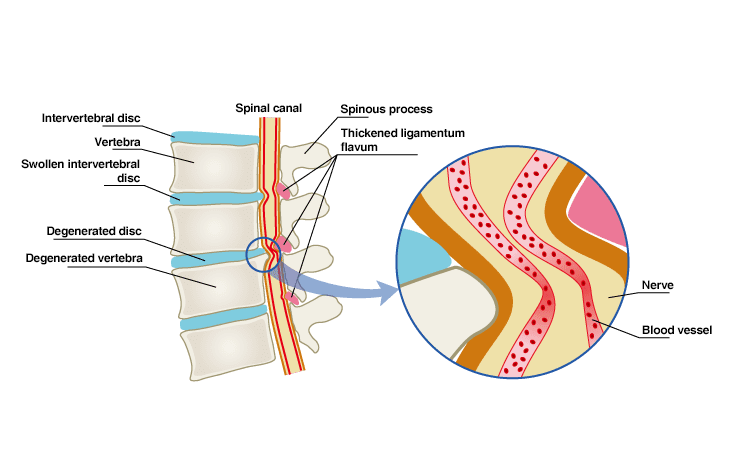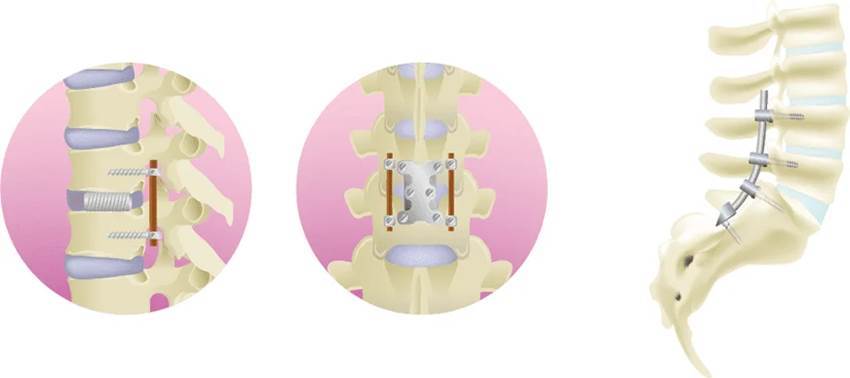Column Diagnosis and Treatment of Spinal Stenosis: Why Early Detection is Critical
February 21, 2025
Along with disc herniation, spinal canal stenosis is the most common spinal disorder.
In this article, we will discuss how to diagnose and treat spinal canal stenosis.
What is spinal canal stenosis?
Spinal canal stenosis is a condition in which the spinal canal, which acts as a pathway for the nerves, narrows, causing compression on the nerves. When it is caused by instability of the lumbar spine, it often triggers pain during physical movements.
Numbness and pain from the waist down may occur with lumbar spinal canal stenosis. This condition is usually characterized by intermittent claudication, a condition in which walking causes pain and numbness in the buttocks and legs, which eases after a short rest, only to return again when the patient resumes the walking.

Diagnosis of Spinal Canal Stenosis
Medical interview and physical examination
The presence or absence of symptoms (back pain, leg pain, numbness, etc.), as well as the location and extent of the symptoms will be ascertained during the medical consultation.
The presence of muscle weakness and paresthesia in the lower limbs will also be evaluated to assess the presence of intermittent claudication, which is a typical symptom of spinal canal stenosis.
Diagnostic Imaging: X-rays, MRI, CT scan
In addition to the examination, diagnostic imaging is also essential.
X-rays images are used to check the condition of the bones and the presence of scoliosis, spondylolisthesis, or fractures.
An MRI scan is performed to determine the degree of nerve compression within the spinal canal and its severity.
If the diagnosis is difficult to make based solely on MRI and X-rays, a CT scan or myelography may be performed.
Early diagnosis of spinal canal stenosis is key
Lumbar spinal canal stenosis is a common condition among the elderly patients.
Symptoms such as intermittent claudication make it difficult to walk and interfere with daily life. Some patients end up not leaving the house and some eventually become bedridden, and not a few of them become subject to depression.
In addition, as the condition progresses, the only option left may be surgery, which is performed under general anesthesia and shave off parts of the spine before stabilizing it with metal parts.
That is why it is essential to get a proper diagnosis before the symptoms become too severe.
Treatment of spinal canal stenosis
Surgery
Lumbar spinal stenosis may be treated with block injections, but the majority of the cases are treated surgically.
The most common surgical procedures for spinal canal stenosis are lumbar laminectomy and spinal fusion.
Lumbar laminectomy is performed under general anesthesia and using an endoscope, the skin of the back is cut open and part of the vertebral arch and thickened ligamentum flavum is removed to relieve nerve compression and widen the spinal canal.
Spinal fusion is performed under general anesthesia by making an incision in the skin of the back, removing the degenerated disc, and placing a cage filled with bone taken from the hip bone to hold the vertebrae in place with screws and rods. It may be performed after a lumbar laminectomy.

Once surgery is performed for spinal stenosis, it is not uncommon for the spinal canal to narrow again afterward, causing a recurrence of the symptoms. In such cases, a high percentage (10% to 23%) require reoperation (*1).
Comorbidities also increase the incidence of postoperative complications and lengthen recovery time. The incidence of comorbidities is particularly high in elderly patients, ranging from 60% to 73.9%. (*2).
Among them, diabetes, dyspnea, chronic obstructive pulmonary disease, and steroids taken in conjunction with chronic medical conditions increase the risk of postoperative complications (*3).
*1: Atlas SJ, et al. Long-term outcomes of surgical and nonsurgical management of lumbar spine stenosis: 8 to 10 year results from the maine lumbar spine study. Spine, 2005, 30(8). Kim CH, et al. Reoperation rate after surgery for lumbar spinal stenosis without spondylolisthesis: a nationwide cohort study. Spine Journal, 2013, vol.13-10.
*2: Khalepa R.V., Klimov V.S. Lumbar spinal stenosis in elderly and senile patients: problem state and features of surgical treatment. Russian journal of neurosurgery. 2017;(1).
*3: Deyo, R. A., Hickam, D., Duckart, J. P., Piedra, M. Complications After Surgery for Lumbar Stenosis in a Veteran Population. Spine. 2013;38(19).
Minimally Invasive Treatments – the Florence and Q Florence Methods
The Florence and Q Florence methods can also be performed on spinal canal stenosis.
The Florence and Q-Florence procedures are minimally invasive, low-risk treatments for spinal stenosis.
Under partial anesthesia and sedation, a device is percutaneously inserted to widen the narrowed spinal canal.
The device is inserted to stabilize the vertebral body while retaining spinal rotation and flexion, widening the spinal canal and reducing disc protrusion and hypertrophy of the ligamentum flavum. Pain is eliminated by the expansion of the narrowed spinal canal.

The Q-Florence Method (in Japanese)
If you have ever been diagnosed with spinal canal stenosis, please consider a consultation at our clinic.
Related Articles
The Different Symptoms of Spinal Canal Stenosis: If You Have Any of These, It’s a Red Flag!
How to Spend Time after Spinal Stenosis Surgery
Is it already too late! ? What should I do about spinal canal stenosis that has been left untreated?
How to Deal with Stenosis Pain and Numbness
What are the Various Complications Possible With Spinal Stenosis?



